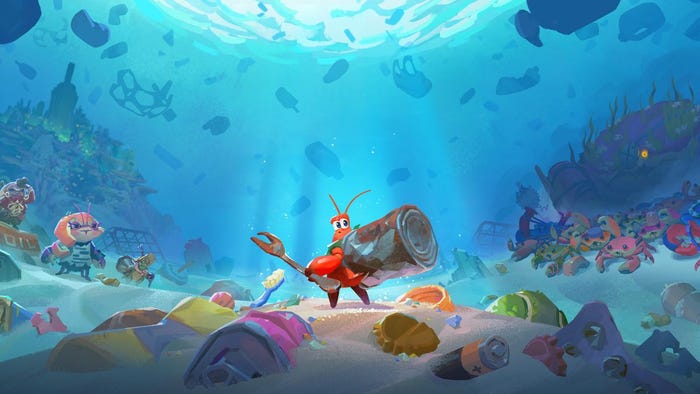This Week in Video Game Criticism: The Glitchhikers' Guide to the Galaxy
This week, our partnership with game criticism site Critical Distance brings us picks from Alan Williamson on topics ranging from the Far Cry 4 cover controversy to the lonely highways of Glitchhikers.

This week, our partnership with game criticism site Critical Distance brings us picks from Alan Williamson on topics ranging from the Far Cry 4 cover controversy to the lonely highways of Glitchhikers. Rules, Norms, and Laws Nintendo's troubling handling of same-sex relationships in Tomodachi Life continues to reverberate through the blogosphere. Todd Harper writes for Polygon about how the choice between diversity and enjoyment is a false one, also referencing a talk given by Blizzard's Rob Pardo at the MIT Media Lab. Zoya Street examines the difference between rules, norms and laws in games, and the implications of labelling same-sex couples in Tomodachi Life a 'bug'. Shinji Matsunaga responds (in both English and Japanese), further teasing apart these ideas. There's a stark contrast between this and the gender-neutral box art of Dragon Age: Inquisition, continuing a trend that started with Dragon Age: Origins and its expansion (although not Dragon Age II, which didn't offer a choice of protagonist). Speaking of box art... Big Trouble in Triple A Town Far Cry 4's box art is, let's be honest, deliberately provocative. At GamesIndustry.biz, Brendan Sinclair remarks that given the series' problems with 'satire', it's reasonable to be wary of giving Ubisoft the benefit of the doubt. What's worse is that the Far Cry 4 Limited Edition has arguably less offensive cover art that could do the same job. This isn't the right place and I am not the right person to discuss this. Thankfully, some other people have discussed it: Shivam Bhatt writes a thoughtful post for Gamasutra about the lack of respect shown to South Asians and Buddhists in general, specifically through the lens of FC4. Colin Moriarty wrote a problematic piece for IGN (content note: the discussion below is the line is racially charged), but the responses are strong: here's a pastiche by Stephen Beirne that exposes its problems and one by Jed Pressgrove on how Moriarty's essay comes across as a marketing exercise rather than criticism. Related, Edward Smith writes about this in relation to Germany's censoring of Wolfenstein: The New Order to remove all references to the Nazis (although we should point out that this is to comply with German law StGB §86 and isn't an isolated incident). On the brighter side of cultural representation, The Financial Post have an interview with Upper One Games, the first U.S.-based indigenous videogame company, where they discuss the development of Never Alone, a game with an Inupiat protagonist and her arctic fox companion. Stories Simon Parkin writes for the Guardian about 1000 Days of Syria, a free online game by an American journalist who covered the conflict in Syria. There must be a new Kentucky Route Zero chapter, because my browser tabs are full of references to it. For Popmatters, G Christopher Williams talks about the performance of 'Too Late to Love You Now' as a postmodern, performative experience. At Storycade, Amanda Wallace pens an open love letter to KRZ. Over at the Escapist, Robert Rath examines what bugged him about Halo 4: when your story ends with a sleeping messiah who's never meant to re-awaken, what happens when they do? Contrasting this hero's journey, Sande Chen writes about the heroine's journey in games and the identification between avatar and player. Brendan Vance explores another journey, this time down the lonely highways of Glitchhikers. In the Dark Nick Dinicola writes about 'the relentless pursuit of progress' in A Dark Room, a game that sounds similar to Candy Box (with all of the addictive apprehension that implies). Also skulking around in the dark, Sevencut take a look at the morality of stealth games: as well as being an interesting article in its own right, it also links to a great series of posts by Cameron Kunzelman on Assassin's Creed, which are worth reading if you haven't done so already. No summary of a week's games writing would be complete without Dark Souls: over at Kill Screen, Jordan Smith uses Dark Souls 2 as the springboard for a discussion about Kierkegaard and existentialism. Still sort of on the subject of 'dark things', Gamasutra has a fascinating postmortem of The Chinese Room's Amnesia: A Machine for Pigs. Interesting Things I Couldn't Otherwise Tenuously Connect Robert Yang blogs about the discontinuity of indoor spaces: discrete ‘cells' separated not just physically, but also by loading screens. A game that treats rooms entirely differently is The Room: Adam Saltsman thinks it's the perfect iOS game (although not necessarily his favourite). Another game that makes the most of touchscreen devices is DEVICE 6. Art of the Title interviews Simogo's Simon Flesser about its visual inspirations. And finally, I haven't played Android: Netrunner (and it's not even a videogame, but hey!) but Dan Cox does a great job of discussing some its interesting asymmetrical concepts and how it relates to his experiences in the classroom. Foreign Correspondence... with Joe Koeller As a follow-up to last week, Hendrik Luehrsen offers more criticism of the German Videogames Award, its political machinations and the stereotypes propagated in its coverage. For April Fools, Superlevel auctioned off a genuine paid-for review on Ebay. This is the result, written by Hendrik Thiel. Elsewhere, Manuela Schauerhammer reviewed two physical Minecraft handbooks, criticizing the lack of content and gendered marketing. Thank you for reading! Please keep sending your contributions by email or by mentioning us on Twitter! If you like the work we do, please consider supporting the Critical Distance Patreon.
About the Author(s)
You May Also Like









